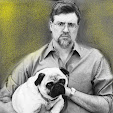 After the readings, Alex and I struck up a conversation about AHMM and working with the magazine's editor, Linda Landrigan. (LL has bought one of my stories and sent some kind rejections. She and her Ellery Queen colleague editor Janet Hutchings are actually pretty terrific, but that's another story.) It turned out that Alex was taking up the editorial mantle, guest editing an issue of The Big Click, with the theme "Bête Noire." The catch was that the issue was going to consider real (fictional) animals, not beastly people. We were informally brainstorming -- and I mentioned the James Garner movie They Only Kill Their Masters and Patricia Highsmith's odd and wonderful, Animal-Lover's Book of Beastly Murder. Alex immediately jumped on the Highsmith title and proposed that I write a "fan's review." My critical muscle hadn't been recently exercised and I was "between books" (as it were, waiting for my agent to respond to a current manuscript), so I agreed to the project.
After the readings, Alex and I struck up a conversation about AHMM and working with the magazine's editor, Linda Landrigan. (LL has bought one of my stories and sent some kind rejections. She and her Ellery Queen colleague editor Janet Hutchings are actually pretty terrific, but that's another story.) It turned out that Alex was taking up the editorial mantle, guest editing an issue of The Big Click, with the theme "Bête Noire." The catch was that the issue was going to consider real (fictional) animals, not beastly people. We were informally brainstorming -- and I mentioned the James Garner movie They Only Kill Their Masters and Patricia Highsmith's odd and wonderful, Animal-Lover's Book of Beastly Murder. Alex immediately jumped on the Highsmith title and proposed that I write a "fan's review." My critical muscle hadn't been recently exercised and I was "between books" (as it were, waiting for my agent to respond to a current manuscript), so I agreed to the project.Rereading Highsmith and writing "The Friendly Animals of Patricia Highsmith: An Appreciation of The Animal-Lover’s Book of Beastly Murder" turned out to be a lot of fun. The piece went live last week -- so check it out on The Big Click. The bonus was getting to hang out with the super-terrific Alex and her posse of other writers. As I said, the moral of the story is that I should get out more often.


